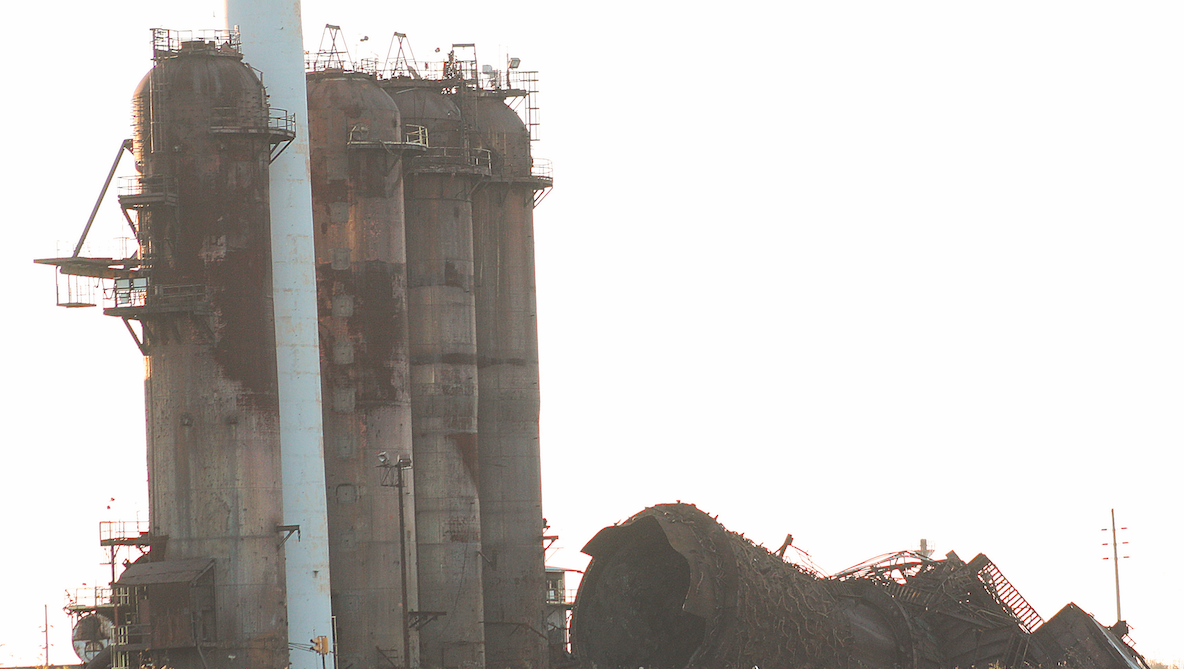Last Valley blast furnace tumbles down in quiet end

Iconic Warren structure tumbles quietly into history
By Ed Runyan
WARREN
The last blast furnace in the Mahoning Valley came down Sunday afternoon on the former Republic Steel property in a dramatic yet quiet way.
The furnace’s hulking framework and huge circular column on the west side of Main Avenue Southwest wasn’t toppled by an explosion. Instead, workers brought it down gently, as if pushing it ever so gently from one side.
When it hit the ground, it did produce a dramatic crash around 12:30 p.m. with only a handful of steelworkers there to watch.
According to Vindicator files, when the blast furnace was in operation, workers using a computerized measuring system combined iron ore, limestone and coke to produce up to 4,000 tons of molten iron ore a day, the first step in the steelmaking process.
A blast furnace is lined with bricks and uses heated air to cause a chemical change that produces liquid iron.
The mill opened in 1913 as the Trumbull Steel Co. and cost $2 million to build. The company became Republic Steel in 1929, then decades later WCI, Severstal and RG Steel.
MCM Management of Michigan had been dismantling the iconic structure since Aug. 2, Tara Cioffi of the Youngstown Health Department and environmental health director for the Mahoning County Air Pollution Control Agency, told The Vindicator Oct. 18.
The demolition work wasn’t obvious from a distance, but it was more obvious upon closer inspection.
On Monday, Cioffi said her agency’s role in the demolition is to ensure asbestos is managed under proper paperwork practices. She said the company had properly notified the agency of asbestos and demolition, but her agency does not regulate the manner in which the demolition is done.
“The owner/operator has met all notification requirements, and it was not necessary or required for them to notify us of the exact time of the demolition,” Cioffi said.
Nonetheless, a representative of Cioffi’s agency did receive a courtesy phone call Saturday indicating the blast-furnace portion of the remaining structures would be demolished Sunday, Cioffi said.
There are still four tall tube structures called “ovens” next to where the blast furnace stood, Cioffi said. One of them has asbestos in it that needs to be removed, but the three others are expected to come down as soon as possible, Cioffi said.
Calls to a representative from MCM and Michael K. Bechtold of BDM Warren Steel Holdings, the owner of the property, were not returned Monday.
The removal of the blast furnace leaves a void in the skyline on the south side of Warren. The structure, one of the most recognizable structures in the county, was plainly visible from downtown Warren.
BDM owns the blast furnace and the rest of the former mill property, having bought it out of bankruptcy in September 2012, after the mill had shut down that May. The closing put about 1,000 steelworkers out of a job.
BDM revealed plans in 2013 to demolish everything on the 1,100-acre Republic Steel/RG Steel mill site and started the demolition soon thereafter. The blast furnace has been described as the final part of the demolition. The part of the property on the east side of Main Avenue has already been leveled.
Many other structures near the blast furnace remain, however, because Arcelor Mittal Warren operates a coke plant there and still uses the boiler formerly connected to the blast furnace in its coke-making operation. The boiler fed heated air to the blast furnace when it was operating.
There had been blast furnaces in the Mahoning Valley for 214 years, with the first one – the Hopewell Furnace in Yellow Creek Park in Struthers – being built in 1803. There are still remnants of two – the Hopewell and Mill Creek Furnace in Mill Creek Park.
 43
43
